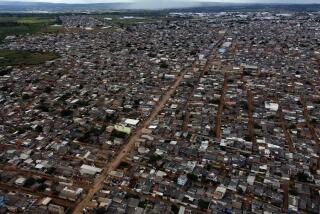Isolated Cape Verde Islands Ripe With Drama and Surprise
- Share via
PRAIA, Cape Verde — The Cape Verde Islands, 400 miles off the coast of Senegal in the Atlantic Ocean, are no tropical paradise. They are obscure, isolated and full of surprises.
The surprises included tropical valleys, miles of beaches, pockets of Portuguese colonial architecture, discos next to churches, turtles laying eggs on deserted volcanic shores, Afro-Portuguese cuisine and an amiable population.
Cape Verde’s terrain is mostly volcanic and barren. And, unless you consider four pages of State Department statistics to be a guidebook, there’s not much literature available. In fact, few of your acquaintances are likely to have even heard of Cape Verde.
Droughts and famines--some of the archipelago’s water supply is brought in by ship--coupled with the earlier historic decline in the slave trade based here has, over the centuries, brought the islands into their present position as one of the poorest nations on Earth.
In its capital city, Praia, streets are strewn with garbage and the buildings are decaying. The best hotel is none too good--with drains that don’t, hot water that isn’t and overripe bananas for breakfast.
So after arriving in the capital, on the island of Sao Tiago, take one of the inter-island flights from Praia to the northern islands, where the drama, the beauty and the unexpected are to be found.
The island of Sao Vicente boasts the country’s most important port, Mindelo, and quite a few Portuguese colonial buildings. Some of that architectural style originates from 1462, when Portuguese settlers first arrived, followed by the slave traders.
Mindelo itself has long served as a Navy fueling and rest haven, and in the early 1800s it was the headquarters of the U.S. Africa Squadron.
The city is certainly the most attractive in the country, with two hotels.
The Aparthotel, offers rooms at $25, double occupancy, with a view of the port. Although the hotel has a minimum of charm, it does have that loveliest of modern devices--air conditioning.
More charming is the Hotel Porto Grande at $22 a room, double occupancy, across the street from the city’s plaza, Praca Amilcar Cabral. At the Porto Grande, rooms only have fans. However, guests can comfortably adjourn to the terrace and enjoy the evening’s breeze and the plaza’s action.
Particularly on Sunday evening, it seems the whole town gathers in its finery, the band booms forth from the raised bandstand, and everyone from youths to grandmothers is dancing among the flowers.
If you want entertainment in Cape Verde, of any variety at all, better get it in Mindelo, because from here on you’re off to the outer islands.
I wandered up the hill to the “Frenchman’s” restaurant; it seemed to be known by no other name. But here I cooled off in a tropical garden and ate fresh local fish sauteed in a tasty sauce--while the Frenchman himself nodded and smiled from behind the bar, apparently unable to talk.
“He’s been in the islands for 12 years,” the waitress told me. “He talks, but it’s too hot for him to talk tonight.”
The Frenchman’s menu, fish and chicken, is typical of Cape Verde’s limited cuisine. There is beef and sometimes chicken or pork, and nearly always fish, along with rice and excellent French-fried potatoes, reminiscent of Brazil.
Although every restaurant in the islands has lobster on the menu, and sometimes shrimp, it seems I’d done it again--arrived when the country’s principal delicacies were out of season, which is from from January to June.
The beverage situation isn’t much different, but a little more amusing. Signs are everywhere for Beck’s beer, Breda or other imports.
But contrary to the signs, there is only one kind of beer available in Cape Verde--Ceris. It’s not bad and it is everywhere. Of course, there are always the crisp, white vinho verde wines imported from Portugal.
In Mindelo, I also ate chow mein at Restaurant China, and discovered cachupa-- the national dish (a sort of hominy-based stew with sausages, ribs and potatoes).
I found my first cachupa by being directed into an alley and then to a doorway where a woman was engaged in a violent verbal exchange with a group of businessmen who had just sent their fish back to the kitchen. The locals refer to this hidden spot as Tchaina.
A third choice would be on the edge of town at Chez Loutcha, which describes itself as Euro-Africana, and dishes out such delicacies as an African egg roll, sea snails and chicken Senegal-style, together with the traditional Portuguese codfish.
A little night life? Try a couple of discos, Chez Ami and, more centrally located, Pimms. As usual in Cape Verde, there’s no sign in front. You’ve just got to ask around, then work your way uphill until you hear the music and spot a giant bouncer sitting outside a door taking money.
I had a hard time discoing in that heat, but the humidity doesn’t keep Pimms from being jammed until late each evening.
If it’s a Sunday night, less than a block away is the Church of the Nazarene, with its evangelical shouting and music.
Late one morning, after wandering through Mindelo’s colorful fish and produce markets, I climbed aboard the small freighter-ferry, the Porto Novo, to cross ($3.60) the channel to Santo Antao.
When I stepped down to the small dock at Santo Antao, duffel bag over my shoulder, I knew where I wanted to go, but not how to get there.
It takes a little questioning. It turned out there are common-carrier pickups to take one across the island to Ribeira Grande, or you can go by bus. I chose bus for one of the most dramatic rides of my life.
My maps had shown that the route led across a high range of volcanic ridges. I figured there was a pass through the range. Wrong.
But I sat in the windshield seat next to Silverio, the driver, my feet up on the dashboard, a bottle of the local version of orange Crush in my hand, enjoying the terrain as we whizzed our way up the narrow, lava rock road, up and up around the hairpin turns on a road wide enough for a bus or a truck--but not for both.
This two hours ($1.50 fare) took us up, away from the sea into pine trees and soft green grass.
We paused occasionally to pick someone up, to hoist their gear to the top of the bus, to let someone off at a community of perhaps three or four huts, to pass out the window the large cake that had been handed to our driver before we left the dock.
At the summit, some 4,300 feet up, almost miraculously Cape Verde changed. Now, for the first time in several days, I was cool, with fog below and greenery in several directions.
Far below was a fertile valley in which corn flourished, and we headed down, plunging along narrow ridges just wide enough for us to pass. We honked loudly as we approached each turn, and I was grateful for the fog because, when it occasionally cleared, I saw that on each side was a sheer drop of 2,000 feet.
And then, horn blasting away, we wove our way into Ribeira Grande, the jump-off spot for the small, hidden Paul Valley, my destination.
I heard that Paul Valley was an Atlantic Ocean version of Herman Melville’s hidden Valley of Typee, which Melville wrote about in “Typee: a Peep at Polynesian Life,” and which I wanted to see.
In Ribeira Grande I hired a pickup and a young driver ($12.50) and we set off up a narrow highway, winding along the lava cliffs high above the heavy surf to the mouth of the valley.
In view of the lack of vegetation throughout much of the island chain, this long, narrow piece of moist greenery is a surprising, welcome oasis. Down from the mountains runs a spring-fed stream that nourishes flourishing breadfruit, mangoes, papayas, sugar cane, bananas, orchids and ginger.
Up the valley we went, through small villages, into the riverbed itself, past swimming holes filled with local kids, up to a distillery where, out of the local cane, aguardiente is made several months of the year.
Aguardiente might best be described as a cross between grappa and brandy. It costs about 18 cents a slug and, standing at the counter at the tiny Mercendaria Valez, it went down with force.
There’s no place to stay for the traveler in the Paul Valley. So, making our way back down past the rock-walled, thatched-roof huts, we went back to Ribeira Grande, where the one hotel, the Residencial Alianca ($15) has passable accommodations, a restaurant and a nice sea breeze. It must have been richer here centuries ago, because Sir Francis Drake plundered the town in 1585.
After Santo Antao, I found one other island that made Cape Verde memorable. I got there by air on a 20-seat Twinotter from Santo Antao, although you can also go by inter-island freighter (most inter-island air fares run from $15-$35).
Coming into the island of Sao Nicolau, it is obvious, especially from the air, that this is perhaps the most attractive of the islands.
Its main town, Ribeira Brava, is set inland in a valley. It’s no cooler in the Sao Nicolau valleys than elsewhere in the Cape Verde Islands, but the island is much greener.
To explore it, I hired a taxi ($25), for a daylong ride down its dramatic coastline, and then up into the highlands where, as they do throughout the islands, the women carry their burdens atop their heads as they walk alongside the road. Divided by rock walls, corn, beans and sugar cane grow in fields. The hillsides are terraced, the fog is frequent, the air fresh and moist.
From Sao Nicolau’s highlands, my taxi dropped us into the hot, humid climate of the coast to drive along gorgeous black beaches.
The driver stopped and I jumped out of my clothes and headed for the warm, refreshing water and gentle surf. That hour or so--on a deserted black-sand beach with the sharp-edged peaks towering overhead--was one of Cape Verde’s pleasantest moments.
Coming out of the water, I noticed a sort of trail also headed out of the water.
It was a moment or two before I realized that this was the path that a sea turtle had made the night before, coming ashore to lay her eggs then returning to the sea. Those eggs might have been tasty, but I had no desire to disturb their resting place.
SUNSET
More to Read
Sign up for The Wild
We’ll help you find the best places to hike, bike and run, as well as the perfect silent spots for meditation and yoga.
You may occasionally receive promotional content from the Los Angeles Times.






